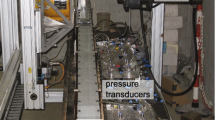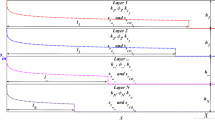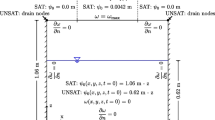Abstract
In this work, we make use of numerical experiments to explore our original theoretical analysis of two-phase flow in heterogeneous porous media (Quintard and Whitaker, 1988). The calculations were carried out with a two-region model of a stratified system, and the parameters were chosen be consistent with practical problems associated with groundwater flows and petroleum reservoir recovery processes. The comparison between theory (the large-scaled averaged equations) and experiment (numerical solution of the local volume averaged equations) has allowed us to identify conditions for which the quasi-static theory is acceptable and conditions for which a dynamic theory must be used. Byquasi-static we mean the following: (1) The local capillary pressure,everywhere in the averaging volume, can be set equal to the large-scale capillary pressure evaluated at the centroid of the averaging volume and (2) the large-scale capillary pressure is given by the difference between the large-scale pressures in the two immiscible phases, and is therefore independent of gravitational effects, flow effects and transient effects. Bydynamic, we simply mean a significant departure from the quasi-static condition, thus dynamic effects can be associated with gravitational effects, flow effects and transient effects. To be more precise about the quasi-static condition we need to refer to the relation between the local capillary pressure and the large-scale capillary pressure derived in Part I (Quintard and Whitaker, 1990).\(\begin{gathered} p_c \left| {_y = \left\{ {p_c } \right\}^c } \right|_x + \left( {\rho _\gamma - \rho _\beta } \right)g \cdot \left( {y - \left\{ y \right\}^c } \right) + \Omega _\gamma \cdot [\left( {y + b_\gamma } \right) - \left\{ {y + b_\gamma } \right\}^c ] - \Omega _\beta \cdot [\left( {y + b_\beta } \right) - \left\{ {y + b_\beta } \right\}^c ] + \hfill \\ + \tfrac{1}{2}\nabla \Omega _\gamma :[\left( {yy + D_\gamma } \right) - \left\{ {yy + D_\gamma } \right\}^c ] - \tfrac{1}{2}\nabla \Omega _\beta :[\left( {yy + D_\beta } \right) - \left\{ {yy + D_\beta } \right\}^c ] + \hfill \\ + [\left( {\mu _\gamma A_\gamma - \mu _\beta A_\beta } \right) - \left\{ {\mu _\gamma A_\gamma - \mu _\beta A_\beta } \right\}^c ]\frac{{\partial \left\{ { \in _\beta } \right\}*}}{{\partial t}} + \hfill \\ + [\left( {\mu _\gamma c_\gamma - \mu _\beta c_\beta } \right) - \left\{ {\mu _\gamma c_\gamma - \mu _\beta c_\beta } \right\}^c ] \cdot \nabla \frac{{\partial \left\{ { \in _\beta } \right\}*}}{{\partial t}} + \hfill \\ + \mu _\gamma (E_\gamma - \left\{ {E_\gamma } \right\}^c ):\nabla \Phi _\gamma - \mu _\beta (E_\beta - \left\{ {E_\beta } \right\}^c ):\nabla \Phi _{\beta \cdot } \hfill \\ \end{gathered} \) Herep c ¦y represents the local capillary pressure evaluated at a positiony relative to the centroid of the large-scale averaging volume, and {p c }¦x represents the large-scale capillary pressure evaluated at the centroid.
In addition to{p c } c being evaluated at the centroid, all averaged terms on the right-hand side of Equation (1) are evaluated at the centroid. We can now write the equations describing the quasi-static condition as\(\left\{ {p_c } \right\}^c = \left\{ {\left\langle {p_\gamma } \right\rangle ^\gamma } \right\}^\gamma - \left\{ {\left\langle {p_\beta } \right\rangle ^\beta } \right\}^\beta ,\),\(p_c \left| {_y = \left\{ {p_c } \right\}^c } \right|_{x \cdot } \), This means that the fluids within an averaging volume are distributed according to the capillary pressure-saturation relationwith the capillary pressure held constant. It also means that the large-scale capillary pressure is devoid of any dynamic effects. Both of these conditions represent approximations (see Section 6 in Part I) and one of our main objectives in this paper is to learn something about the efficacy of these approximations. As a secondary objective we want to explore the influence of dynamic effects in terms of our original theory. In that development only the first four terms on the right hand side of Equation (1) appeared in the representation for the local capillary pressure. However, those terms will provide an indication of the influence of dynamic effects on the large-scale capillary pressure and the large-scale permeability tensor, and that information provides valuable guidance for future studies based on the theory presented in Part I.
Similar content being viewed by others
Abbreviations
- A βω :
-
scalar that maps ∂{∈β}*/∂t onto\(\hat p_{\beta \omega } \)
- A βη :
-
scalar that maps ∂{∈β}*/∂t onto\(\hat p_{\beta \eta } \)
- A ωη :
-
interfacial area between the ω-region and the η-region contained within
, m2
- A ωσ :
-
interfacial area between the ω-region and the σ-region contained within
, m2
- A ησ :
-
interfacial area between the σ-region and the σ-region contained within
, m2
- a βω :
-
vector that maps (∂{∈β}*/∂t) onto\(\hat v_{\beta \omega } \), m
- a βη :
-
vector that maps (∂{∈β}*/∂t) onto\(\hat v_{\beta \eta } \), m
- b βω :
-
vector that maps (∇{〈pβ〉β}β−ρβ g) onto\(\hat p_{\beta \omega } \), m
- b βη :
-
vector that maps (∇{〈pβ〉β}β−ρβ g) onto\(\hat p_{\beta \eta } \), m
- B βω :
-
second order tensor that maps (∇{〈pβ〉β}β−ρβ g) onto\(\hat v_{\beta \omega } \), m2
- B βη :
-
second order tensor that maps (∇{〈pβ〉β}β−ρβ g) onto\(\hat v_{\beta \eta } \), m2
- c βω :
-
vector that maps (∇∂{∈β}*/∂t) onto\(\hat p_{\beta \omega } \), m
- c βη :
-
vector that maps (∇∂{∈β}*/∂t) onto\(\hat p_{\beta \eta } \), m
- C βω :
-
second order tensor that maps (∇∂{∈β}*/∂t) onto\(\hat v_{\beta \omega } \), m2
- C βη :
-
second order tensor that maps (∇∂{∈β}*/∂t) onto\(\hat v_{\beta \eta } \). m2
- D βω :
-
third order tensor that maps (∇Ω β) onto\(\hat v_{\beta \omega } \), m
- D βη :
-
third order tensor that maps (∇Ω β) onto\(\hat v_{\beta \eta } \), m
- D βω :
-
second order tensor that maps (∇Ω β) onto\(\hat p_{\beta \omega } \), m2
- D βη :
-
second order tensor that maps (∇Ω β) onto\(\hat p_{\beta \eta } \), m2
- E βω :
-
third order tensor that maps (ΔΦ) onto\(\hat v_{\beta \omega } \), m
- E βη :
-
third order tensor that maps (ΔΦ) onto\(\hat v_{\beta \eta } \), m
- E βω :
-
second order tensor that maps (ΔΦ) onto\(\hat p_{\beta \omega } \)
- E βη :
-
second order tensor that maps (ΔΦ) onto\(\hat p_{\beta \eta } \)
- ℱω :
-
p c =ℱω(∈βω), capillary pressure relationship in theω-region
- ℱη :
-
p c =ℱη(∈βη), capillary pressure relationship in theη-region
- g :
-
gravitational vector, m/s2
- ℋ:
-
largest of either ℋω or ℋη
- ℋω :
-
- ℋη :
-
- i :
-
unit base vector in thex-direction
- I :
-
unit tensor
- K β :
-
local volume-averagedβ-phase permeability, m2
- K ω :
-
local volume-averagedβ-phase permeability in theω-region, m2
- K η :
-
local volume-averagedβ-phase permeability in theη-region, m2
- {K β}β :
-
large-scale intrinsic phase average permeability for theβ-phase, m2
- \(\hat K_\beta \) :
-
K β−{K β}β, large-scale spatial deviation for theβ-phase permeability, m2
- \(\hat K_{\beta \omega } \) :
-
K βω−{K β}β, large-scale spatial deviation for theβ-phase permeability in theω-region, m2
- \(\hat K_{\beta \eta } \) :
-
K βη−{K β}β, large-scale spatial deviation for theβ-phase permeability in theη-region, m2
- K *β :
-
large-scale permeability for theβ-phase, m2
- L :
-
characteristic length associated with local volume-averaged quantities, m
- ℒ :
-
characteristic length associated with large-scale averaged quantities, m
- I i :
-
i = 1, 2, 3, lattice vectors for a unit cell, m
- l ω :
-
characteristic length associated with theω-region, m
- ; η :
-
characteristic length associated with theη-region, m
- l H :
-
characteristic length associated with a local heterogeneity, m
- ℳβ :
-
\(\{ (\hat K_\beta + \Delta \{ K_\beta \} ^\beta ) \cdot \nabla D_\beta \} + \{ K_\beta \} ^\beta \cdot \{ \nabla D_\beta \} , m^3 \)
- n ωη :
-
unit normal vector pointing from theω-region toward theη-region (n ωη=−n ηω)
- n ωσ :
-
unit normal vector pointing from theω-region toward theσ-region (n ωσ=−n σω)
- p β :
-
pressure in theβ-phase, N/m2
- 〈p β〉β :
-
local volume-averaged intrinsic phase average pressure in theβ-phase, N/m2
- {〈p β〉β}β :
-
large-scale intrinsic phase average pressure in the capillary region of theβ-phase, N/m2
- 〈p β〉 βω :
-
local volume-averaged intrinsic phase average pressure for theβ-phase in theω-region, N/m2
- 〈p β〉 βη :
-
local volume-averaged intrinsic phase average pressure for theβ-phase in theη-region, N/m2
- \(\hat p_\beta \) :
-
〈p β〉β−{〈p β〉β}β, large scale spatial deviation for theβ-phase pressure, N/m2
- \(\hat p_{\beta \omega } \) :
-
〈p β〉 βω −{〈p β〉β}β, large scale spatial deviation for theβ-phase pressure in theω-region, N/m2
- \(\hat p_{\beta \eta } \) :
-
〈p β〉 βη −{〈p β〉β}β, large scale spatial deviation for theβ-phase pressure in theη-region, N/m2
- P c :
-
〈p γ〉γ−{〈p β〉β}β, capillary pressure, N/m2
- {pc}c :
-
large-scale capillary pressure, N/m2
- r 0 :
-
radius of the local averaging volume, m
- R 0 :
-
radius of the large-scale averaging volume
, m
- r :
-
position vector, m
- ℛβ :
-
\(\{ (\hat K_\beta + \Delta \{ K_\beta \} ^\beta ) \cdot \nabla E_\beta \} + \{ K_\beta \} ^\beta \cdot \{ \nabla E_\beta \} , m\), m
- S β :
-
∈β/∈, local volume-averaged saturation for theβ-phase
- S *β :
-
{∈β}*{∈}*, large-scale average saturation for theβ-phaset time, s
- t :
-
time, s
- u β :
-
\(\{ (\hat K_\beta + \Delta \{ K_\beta \} ^\beta ) \cdot \nabla A_\beta \} + \{ K_\beta \} ^\beta \cdot \{ \nabla A_\beta \} , m\), m
- U β :
-
\(\{ (\hat K_\beta + \Delta \{ K_\beta \} ^\beta ) \cdot \nabla c_\beta \} + \{ K_\beta \} ^\beta \cdot \{ \nabla c_\beta \} , m^2 \), m2
- v β :
-
β-phase velocity vector, m/s
- 〈v β〉ω :
-
local volume-averaged phase average velocity for theβ-phase in theω-region, m/s
- 〈v β〉η :
-
local volume-averaged phase average velocity for theβ-phase in theη-region, m/s
- {〈v β〉}β :
-
large-scale intrinsic phase average velocity for theβ-phase in the capillary region of theβ-phase, m/s
- {〈v β〉}:
-
large-scale phase average velocity for theβ-phase in the capillary region of theβ-phase, m/s
- \(\hat v_\beta \) :
-
〈v β〉−{〈v β〉}β, large-scale spatial deviation for theβ-phase velocity, m/s
- \(\hat v_{\beta \omega } \) :
-
〈v β〉ω−{〈v β〉}β, large-scale spatial deviation for theβ-phase velocity in theω-region, m/s
- \(\hat v_{\beta \eta } \) :
-
〈v β〉η−{〈v β〉}β, large-scale spatial deviation for theβ-phase velocity in theη-region, m/s
- V :
-
local averaging volume, m3
- V β :
-
volume of theβ-phase in
, m3
- V ∞ :
-
large-scale averaging volume, m3
- V β :
-
capillary region for theβ-phase within
, m3
- V γ :
-
capillary region for theγ-phase within
, m3
- V c :
-
intersection of
m3
- V ω :
-
volume of theω-region within
, m3
- V η :
-
volume of theη-region within
, m3
- V ω(β):
-
capillary region for theβ-phase within theω-region, m3
- V η(β):
-
capillary region for theβ-phase within theη-region, m3
- V σ(β):
-
, region in which theβ-phase is trapped at the irreducible saturation, m3
- y :
-
position vector relative to the centroid of the large-scale averaging volume, m
- ∈:
-
local volume-averaged porosity
- ∈β :
-
local volume-averaged volume fraction for theβ-phase
- ∈βω :
-
local volume-averaged volume fraction for theβ-phase in theω-region
- ∈βη :
-
local volume-averaged volume fraction for theβ-phase in theω-region
- ∈βσ :
-
local volume-averaged volume fraction for theβ-phase in theω-region (This is directly related to the irreducible saturation.)
- {∈β}β :
-
large-scale intrinsic phase average volume fraction for theβ-phase
- {∈β}:
-
large-scale phase average volume fraction for theβ-phase
- {∈β}*:
-
large-scale spatial average volume fraction for theβ-phase
- \(\hat \in _\beta \) :
-
∈β−{∈β}β, large-scale spatial deviation for theβ-phase volume fraction
- \(\hat \in _{\beta \omega } \) :
-
∈βω−{∈β}β, large-scale spatial deviation for theβ-phase volume fraction in theω-region
- \(\hat \in _{\beta \eta } \) :
-
∈βη−{∈β}β, large-scale spatial deviation for theβ-phase volume fraction in theη-region
- ψ β :
-
a generic local volume-averaged quantity associated with theβ-phase
- ρ β :
-
mass density of theμ-phase, kg/m3
- ρ γ :
-
mass density of theγ-phase, kg/m3
- μ β :
-
viscosity of theβ-phase, N s/m2
- μ γ :
-
viscosity of theγ-phase, N s/m2
- σ :
-
interfacial tension of theβ -γ phase system, N/m
- Φ β :
-
\(\left\{ {(\hat K_\beta + \Delta \{ K_\beta \} ^\beta ) \cdot \Delta \Omega _\beta } \right\} + \left\{ {K_\beta } \right\}^\beta \cdot \left\{ {\Delta \Omega _\beta } \right\}\), N/m
- φ β :
-
, volume fraction of theβ-phase capillary (active) region
- φ γ :
-
, volume fraction of theγ-phase capillary (active) region
- φ ω :
-
, volume fraction of theω-region (φ ω+φ η=1)
- φ η :
-
, volume fraction of theη-region (φ ω+φ η=1)
- Ω β :
-
∇{〈p β〉β}β−ρβ g, N/m3
- Ω γ :
-
∇{〈p γ〉γ}γ−ργ g, N/m3
References
Aziz, K. and Settari, A., 1979,Petroleum Reservoir Simulation, Applied Science Publishers, London.
Baveye, P. and Sposito, G., 1984, The operational significance of the continuum hypothesis in the theory of water movement through soils and acquifers,Water Resour. Res. 20, 521–530.
Bertin, H., Quintard, M., Corpel, P. V., and Whitaker, S., 1990, Two-phase flow in heterogeneous porous media III: Laboratory experiments for flow parallel to a stratified system,Transport in Porous Media 5, 543–590.
Birkhoff, G., 1960,Hydrodynamics, A Study in Logic, Fact, and Similitude, Princeton University Press, Princeton, NJ.
Cushman, J. H., 1984, On unifying the concepts of scale, instrumentation and stochastics in the development of multiphase transport theory,Water Resour. Res. 20, 1668–1676.
Ewing, R. E. (ed.), 1983,The Mathematics of Reservoir Simulation, SIAM, Philadelphia.
Howes, F. A. and Whitaker, S., 1985, The spatial averaging theorem revisited,Chem. Engng. Sci. 40, 1387–1392.
Mantoglou, A. and Gelhar, L., 1987, Effective hydraulic conductivities of transient unsaturated flow in stratified soils,Water Resour. Res. 51–67.
Puiggali, J. R., Quintard, M., and Whitaker, S., 1988, Drying granular porous media, gravitational effects in the isenthalpic regime and the role of diffusion models,Drying Technol. 6(4), 601–629.
Quintard, M. and Puiggali, J. R., 1986, Numerical modelling of transport processes during the drying of a granular porous medium,Heat Technol. 4(2), 37–57.
Quintard, M. and Whitaker, S., 1987. Ecoulements monophasiques en milieu poreux, effet des hétérogénéités locales,J. Méca. Théo. Appl. 6, 691–726.
Quintard, M., and Whitaker, S., 1988, Two-phase flow in heterogeneous porus media, the method of large-scale averaging,Transport in Porous Media 3, 357–413.
Quintard, M. and Whitaker, S., 1990, Two-phase flow in heterogeneous porous media I: The influence of large spatial and temporal gradients,Transport in Porous Media 5, 341–379.
Sorbie, K. S., Swat, R. M., and Rowe, T. C., 1987, Oil displacement experiments in heterogeneous cores. Analysis of recovery mechanism,Trans AIME SPE,No. SPE 16706.
Whitaker, S.. 1986a, Flow in porous media II: The governing equations for immiscible, two-phase flow,Transport in Porous Media 1, 105–125.
Whitaker, S., 1986b, Multiphase transport phenomena: Matching theory and experiment, in G. Papanicolaou (ed),Advances in Multiphase Flow and Related Problems, SIAM, Philadelphia, pp. 273–295.
Author information
Authors and Affiliations
Rights and permissions
About this article
Cite this article
Quintard, M., Whitaker, S. Two-phase flow in heterogeneous porous media II: Numerical experiments for flow perpendicular to a stratified system. Transp Porous Med 5, 429–472 (1990). https://doi.org/10.1007/BF01403477
Received:
Revised:
Issue Date:
DOI: https://doi.org/10.1007/BF01403477




